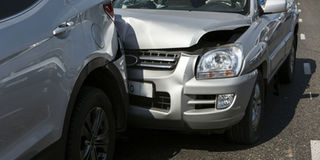Avoid traffic conflicts to prevent road crashes

Traffic conflicts may cause accidents when you assume that the road ahead is clear. file Photo.
What you need to know:
A number of traffic conflicts occur because motorists are always in a hurry and do not want to follow rules. By being courteous, you as a motorist can avoid many of the crashes that happen on our roads.
In road safety terms, a traffic conflict happens when you and other motorists or road users want to use the same space of the road at the same time, for example at a junction.
Take an example of a three minute video clip that was captured on street cameras on Gayaza Road towards Kalerwe market in Kampala. In the clip, a commuter taxi is seen parked by the roadside loading passengers. At the same time, there is also a motorcyclist waiting for a passenger a few inches behind the commuter taxi. In the blink of an eye, a moving trailer also emerges from the moving traffic lane determined to overtake the taxi and motorcyclist.
Between two cars
Because a motorcyclist does not use the riding side mirror or even look behind before setting off, he decides to join the road. What happens is that the motorcyclist and his passenger are crashed between the parked taxi and the trailer. The trailer driver did not have enough space to spare the lives of the motorcyclist and his passenger because the oncoming and outgoing traffic sides were separated by permanent guard rails.
This incident is one of probably a thousand other examples of how traffic conflicts lead to severe road crashes.
Paul Kwamusi, a road safety consultant at Integrated Transport Systems Limited, says traffic conflicts cause accidents because sometimes, you assume that you will continue driving through a junction yet another road user also has the same thought. In the end, you knock other motorists’ cars or other road users because there was no prioritisation on who goes first. This explains why you will find motorists on the road almost grabbing each other’s throats, with each one accusing the other of knocking their car.
Assumption that the road is clear
Traffic conflicts may also cause accidents when you assume that the road ahead is clear. For instance last week, all 15 occupants of a commuter taxi died when the taxi rammed into a parked truck loaded with sugarcane in Mayuge District. Police reports indicate that the taxi driver was speeding and did not see the truck.
“When driving, do not assume anything. If your road visibility is compromised, it means your observation and judgement will also be comprised and this leads to unforeseen crashes,” Kwamusi cautions.
In the case of the above scenario where a motorcyclist was crashed between the commuter taxi and trailer, Kwamusi says the space the trailer was supposed to use became small and the motorcyclist and his passenger were severely victimised. In a traffic conflict, the smallest car or road user is the biggest victim.
To avoid traffic conflict crashes, Kwamusi strongly advises you to reduce your driving speed when approaching junctions regardless of whether it is day or night. If another road user shows signs of entering a junction first or when they are coming from a feeder road, play it safe and let them go.
Allan Ssempebwa Kyobe, the media relations manager at Uganda National Roads Authority, says road safety is a shared responsibility where you must drive in a way that is considerate of other road users by reading and abiding by road signs.
“When roads are under construction, there are always sign posts when approaching junctions or any other points with zebra crossings or humps to warn you of what you should expect ahead. All roads are safe as long as you abide by and respect what is communicated to you,” Ssempebwa reminds.
Much as traffic conflicts normally take place at junctions, they also happen along highways and expressways. For instance, on the Entebbe expressway, there are two lanes on either side of the oncoming and outgoing lanes. These have consistently been abused and this has lately led to accidents. If you use Entebbe expressway and you drive at a slow speed of, say, 40km/hour, you are supposed to be in the extreme left lane and leave the one on the right for motorists overtaking.
“If you remain in the right lane and you drive at a slow speed, it means you will have forced another road user to overtake from the left, which is wrong. When you eventually remember to go to the left lane, there are chances that you will be involved in a traffic conflict you caused, hence a crash,” Ssempebwa advises.
Above all, most of the crashes from traffic conflicts are caused by impatience. If you understand that roads are meant to be used by everyone and drive with a lot of cautiousness and patience, then most accidents would be avoided.
What to remember
• Give other drivers a break. If someone is driving slowly, keep in mind they might be lost.
• Use hand gestures wisely. Keep gestures positive—say, waving to a driver who lets you in when merging.
• Do not tailgate. Always keep a safe distance from the car in front, no matter how slowly they might be driving.
• Lay off the horn. Honking out of frustration will not solve any problems.
www.geico.com




